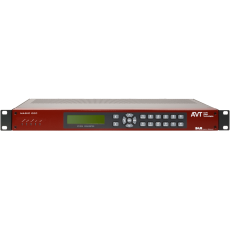Magic EEC ETI/EDI Converter
Typical applications are Ensemble Multiplexers, which cannot generate an ETI signal anymore (e. g. Fraunhofer ContentServer), but which must be fed to the transmitter via E1 lines with ETI or Ensemble Multiplexers, which only have ETI inputs/outputs (e. g. Rohde & Schwarz DM001), but which are to be fed via IP lines with EDI.
The system has two LAN interfaces by default. These are freely programmable in terms of functions, configuration, monitoring, SNMP and EDI input/output. The ETI interface has one G. 703/G. 704 input/output each.
The system is configured via the PC software included in the scope of delivery and displays the status of the ETI or EDI input data streams and all system parameters in a very clear manner. All events are stored in the device in a log file, which can be retrieved via the PC software or alternatively stored in a network folder.
MAGIC EEC supports SNMP v1/v2c protocol for connection to up to four independent network management systems.
In addition, alarm messages can be output via eight potential-free and programmable contacts. Alternatively, eight programmable TTL GPIO contacts are available.
FEATURES
- ETI → EDI and EDI → ETI conversion
- 2 x LAN interfaces
- Monitoring output
- SNMP v1/v2c
- VLAN support
- GPIO contacts
Monitoring Output
A second ETI module can be optionally equipped, which means that an additional unrestricted ETI output is available. This can be used, for example, as a monitoring output or to supply a redundant Ensemble Multiplexer.

SDC Upgrade
The optional SDC upgrade allows a MAGIC EEC system to be upgraded to a full-featured MAGIC SDC Switch & Converter.
Dual Converter Mode
With this upgrade MAGIC EEC has two independent ETI/EDI converters. For the Dual Converter mode you need a MAGIC EEC with monitoring output (second ETI module).
LAN 3/4 Upgrade
Optional extension with two additional Ethernet interfaces. The assignment of functions such as EDI, SNMP etc. is freely configurable.
However, a second ETI module can then no longer be assembled.


